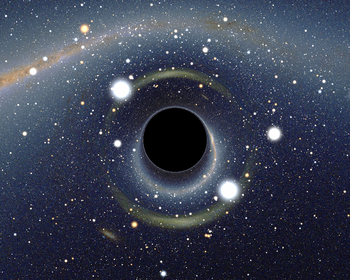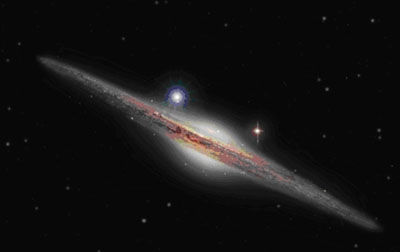Update: 07/06/2009

In astrophysics, a black hole is a massive object the gravitational field of which is so intense that it prevents any form of matter or radiation from escaping. The matter trapped by a black hole is being heated to high temperatures before getting swallowed up and thus emits a large quantity of X-rays which makes its detection possible. The astrophysicists showed the existence of two populations of black holes:
- The black holes with stellar mass, of three to twenty solar masses, resulted from the gravitational collapse of a massive star (approximately ten solar masses and more). In fact, when the thermonuclear combustion ends within the heart of the massive star after running out of fuel, a supernova is produced. The latter can leave behind a nucleus which would keep collapsing quickly.
- The super-massive black holes, of various billion solar masses, are located in the centre of the galaxies. Their formation process is still the subject of much debate. One hypothesis is that the super-massive black holes resulted from the accretion of black holes with intermediate masses. To confirm this theory, it is crucial to prove the existence of such black holes with from some a hundred to hundreds of thousands of solar masses.
An international team led by investigators of the Centre for the Study of Radiation in Space (INSU-CNRS, University Paul Sabatier) analysed the data of the ESA's XMM-NEWTON X-ray observatory. They detected a new source the X-ray emission of which seemed to be a black hole's. This source called HLX-1 (standing for Hyper-Luminous X-ray source) was located on the outskirts of the ESO 243-49 galaxy, 290 million light years away from us, i.e. 2740 billion km (with z=0.02). Its X-ray luminosity was outstanding (approximately 260 million times the total Sun's luminosity) and the idea of it being associated to the central nucleus of the galaxy was ruled out because of its eccentric position.

Thanks to two observations performed on November 23rd 2004 and November 28th 2008 by the XMM-NEWTON satellite, the team showed that HLX-1 was variable. A superposition of various X-ray sources was thus impossible. The extreme luminosity as well as the X-ray emission properties could be explained by a black hole with a mass of more than 500 solar masses. That is why HLX-1 is the most plausible candidate so far which could be part of the so long-sought black hole class with intermediate masses.
Super-massive black holes are omnipresent in the galaxy centres and the Milky Way Galaxy is no exception. However, their formation mechanisms are still an open question. The discovery of HLX-1 was thus a crucial step which was supposed to enable the intermediate-mass black holes' role in the formation of super-massive black holes to be better understood.
Article references
An Intermediate Mass Black Hole of ? 500 Solar Masses in the Galaxy ESO 243-49. Sean A. Farrell1, Natalie A. Webb1, Didier Barret1, Olivier Godet2 & Joana M. Rodrigues1. Nature 02/07/2009.
1 Centre d'Etude Spatiale des Rayonnements CESR, (INSU-CNRS, Université Paul Sabatier ), Toulouse
2 Department of Physics and Astronomy, University of Leicester, Angleterre
Contacts
- Scientific contact : Didier Barret
- CNES Astrophysics programme scientist: Olivier La Marle